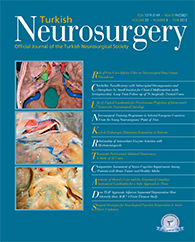2Sichuan University, Westchina Medical School, P. R. China DOI : 10.5137/1019-5149.JTN.4634-11.1 AIM: To explore the surgical effect of cerebellar tonsillectomy with suboccipital decompression and duraplasty by small surgical incision (3~4cm around the foramina magnum) on treating Chiari I Malformation (CM I) patients.
MATERIAL and METHODS: A retrospective study was undertaken on 76 CM I patients treated by this surgery. The surgical efficacy on clinical symptoms and syringomyelia were overall evaluated and analyzed.
RESULTS: The study included 76 cases (36 men and 40 women; age range, 5–58 years; mean age at surgery, 38.8 years). Preoperative MRI confirmed 56 cases associated with syringomyelia. The follow-up period ranged from 25 to 58 months (median, 46 months). At the end of follow-up, 61 patients (80.26%) had improved, 12 patients (15.79%) were stabilized, and 3 patients (3.95%) had worsened. In MRI scan, syrinx of 55 patients (98.21%) had improved or stabilized compare with syrinx growth in only one patient (1.79%). Statistical analysis reveal the surgical effect tend to be much better in patients with short duration of preoperative symptoms (P=0.001).
CONCLUSION: Cerebellar tonsillectomy with suboccipital decompression and duraplasty can provide long-time cure for most CM I cases. Early diagnosis and surgery is necessary to improve the surgical effect. A 3~4cm incision around foramen magnum is enough for these operations and may be conducive to reduce postoperative complications.
Keywords : Chiari malformation, Syringomyelia, Small incision, Surgery, Tonsillectomy, Suboccipital decompression




